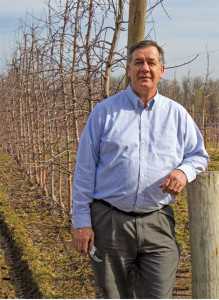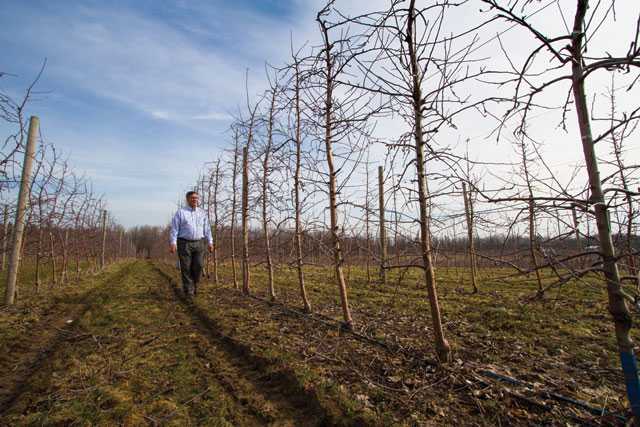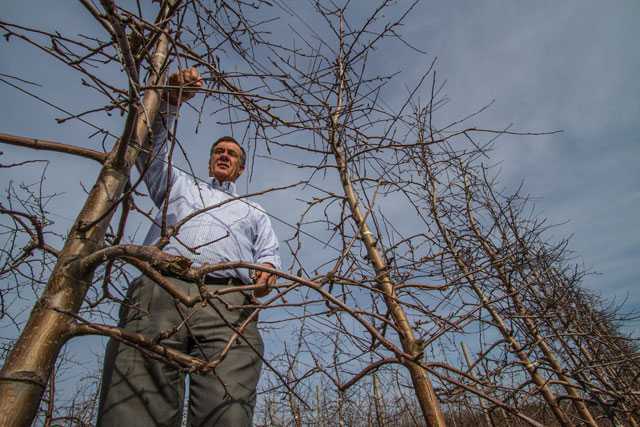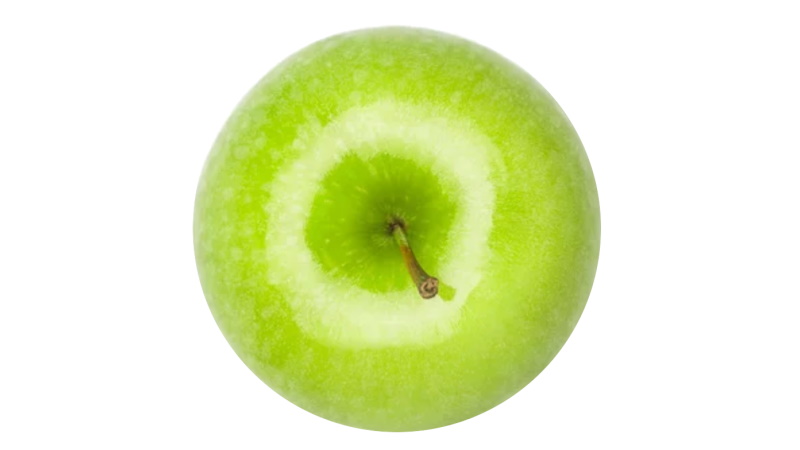Terence Robinson On The Orchard Of The Future
Terence Robinson is everywhere. As one of the world’s leading tree physiologists, he is asked to speak all over the globe — from China, to South America, to Europe, Canada, and Mexico. Just this past month, he was selected as a recipient of the 2014 American Society for Horticultural Science Outstanding Extension Educator Award.
Robinson has been with Cornell University since 1984. He received his Bachelor of Science degree from Brigham Young University and his Master of Science and Doctorate of Science from Washington State University.
When he speaks, growers listen — and with good reason. He is an outspoken proponent of the tall spindle growing system. He sees his research and outreach as solving fruit production problems to increase the economic viability of fruit growers.
Not everyone agrees with Robinson, often citing the up-front expense of planting a high-density orchard. They see the tall spindle growing system he advocates as just another way to grow apples.
But, what Robinson is talking about is more about maximizing the economic potential of your orchard — and your business — than it is simply about growing trees.
American Fruit Grower and Western Fruit Grower sat down with him to talk about why growers are hesitant to plant high-density orchards, the money they leave behind in not doing so, and what he thinks orchards should look like 10 years after planting.
Here, in his own words, is Terence Robinson’s vision for the orchard of the future and how growers can ensure long-term success of the industry.

Photo credit: Rob Way, Cornell University
We’re at a point in time where a number of technologies have come together to give us a slightly different way of growing apples that I think is going to be the way of the future and will be better economically for apple growers. I think it will be more profitable. We’ll end up with higher-quality fruit that we’ll be able to sell to consumers at a good price. All the different technologies can be viewed as pieces of the puzzle, which we believe fit together well into this system we call tall spindle.
The system is built around an economic optimum. If we look at a 20-year life [of an orchard], growers either can invest a smaller initial amount with planting low-density or a higher amount with high-density. That’s an economic question.
In the training system economic study Alison DeMarree, Steve Hoying and I did, the optimum economic planting density seems to keep coming back to what I would call medium-high-density orchards — somewhere around 1,000 to 1,300 trees per acre. Thus, we’ve developed a whole management scheme around that density that we call the tall spindle.
It is more expensive than a low-density orchard, but the reason you invest that extra money is to achieve much higher profitability over 20 years. We’re trying to capture those dollars that are there on the table but aren’t seen.
Growers have generally come around to the concept that you have to invest a little more in trees in the beginning to make more money over the life of the orchard. Those who may not fully buy into that [idea] focus on the initial cost for them to plant a tall spindle orchard. That’s the only thing they’re looking at rather than how much money they could make with a high-density orchard.
Rod Farrow, who runs and owns LaMont Fruit Farms, [in Waterport, NY] has tried to point out to growers there’s money you could have made. You never see it when you plant a low-density orchard because it doesn’t yield as much or as quick as a high-density orchard. You don’t see that as an expense, but it’s money that you could have had, you could have earned.
When you plant trees close together [3 feet], it is true you have to do some things different — on the basic plant physiology level — to hold an apple tree into that space. Apple trees naturally want to grow bigger than that space. This requires a different approach to managing the canopy, managing vigor. We do a few things different in managing the canopy to try to capture the economic benefit that we think is maximized at this planting density.
Given the high investment of a tall spindle orchard, we’ve had a focus on each one of the different variables and factors that could be optimized in the year of planting, the second year, third year, fourth year, and fifth year to try to see how much we could push the yield earlier to pay off the initial investment. What you do over the first five years is hopefully going to be good enough to pay the entire investment off and already start producing a profit.
In the East, we’ve been trying to push people to find water sources and irrigate their orchards, because that small addition can really help to boost the yield in the first five years and achieve this kind of payback that we’re looking for.
What I’m seeing more and more and more is the problem where the trees didn’t grow well enough. They just didn’t quite fill the space. That’s been a problem with Honeycrisp because it’s a low-vigor, slow-growing variety. We are focusing more of our efforts in Extension on trying to help growers push the trees with intensive nitrogen and intensive irrigation in the first five years.
Too little vigor is a real problem. Once the problem is there, it’s very difficult to get out of it. It’s much better to plan differently and start differently.
As I look to the future, I think we’re going to focus a lot of growers’ attention on matching rootstock vigor and scion vigor and the quality of tree you buy — to get the kind of yield we’re after in the first five years. We now have available the series of Geneva rootstocks which have a range of vigor levels from ones that are similar in vigor to M.9 to ones that are 30% more, 40% more. This will allow us to match variety with rootstock to fit a particular soil to more consistently reach this goal of filling the space that we’re giving that 10-foot tall spindle tree in the first two to two-and-a-half years.

Photo credit: Rob Way, Cornell University
The big challenge for apple growers in the future is to manage [orchards] with significantly lower labor investments than they have in the past, but with substantially better yield and better fruit quality. That’s almost like asking ‘Can you have your cake and eat it too?’ I think it’s possible.
I think we could manage a high-density tall spindle orchard for about 162 total [labor] hours per acre. In the past, we’ve been utilizing much more than that, about 240 labor hours per acre. Possibly, we can get down to 130.
Partial mechanization of different orchard tasks is allowing us to reduce labor costs significantly. Self-steering platforms — simple ones that can be used for dormant pruning can reduce costs by 40%; the multi-level platforms can reduce hand-thinning costs by almost half. Sidewall shearing machines used on a tall spindle tree in the summer before harvest can reduce summer pruning costs substantially. The multi-level harvest platforms can reduce harvest costs by 30%.
Although the reduction of labor cost is important in our concept of ‘orchards of the future,’ producing high yields of very high-quality fruit is more important. I think this can be done with precision orchard management.
The second half of my vision for ‘orchards of the future’ is an effort to try to manage the crop very precisely to maximize yield of high quality fruit and reduce variability in fruit quality. We’ve coined this term, ‘precision orchard management’ — or POM — to describe a suite of practices that are aimed at achieving high yields and trying to get every apple to be exactly the same high quality across the tree canopy and across and across an acre.
Sometimes when you go to high yields, fruit quality suffers. This is a physiological issue — the tree can only produce a certain amount of resources. When the crop load is too high, each apple ends up with low dry matter, or the actual carbohydrates that the tree has put into it. Those low dry matter fruits are not high quality and give the consumer a poor eating experience.
How do you manage these trees so you get high yields and high quality? That’s where the precision orchard management ideas fit in. An important first step is precision fertilization, in which we try to fertilize exactly what the crop needs and try to manage the different soils across an acre slightly differently by using GPS maps of soil variability and fertilize with variable rate fertilization. In theory, every tree in that acre will be getting the right amount of nutrition to optimize its performance.
The second and most important part of precision orchard management is trying to get the fruit number on the tree to exactly what we want. Tall spindle trees at 1,300 trees per acre should usually have around 120 apples, which we call the target fruit number. Through precision crop load management we use both pruning to reduce the number of buds to a certain number, usually 1.5 times the target number, and chemical thinning with both the carbohydrate model and fruit growing model in a very structured and elaborate thinning protocol, to reduce the number of fruits on the tree right down to the 120 number.
That gives us the maximum potential to get fruit size and adequate carbohydrates into those fruits for high fruit quality.
As we envision how we will be producing apples over the next 20 years, the basic principles of fruit physiology are not going to change. We will have to have good light exposure on all parts of the tree canopy. We have to intercept a lot of light to get high yields. We have to grow the tree as quickly as we can, to fill the space because every day that it’s not filling the space is wasted; we’re not producing apples where we could.
Through this effort we are making to speak about ‘orchards of the future’ we are trying to help growers put all of the puzzle pieces together in one package.
If they don’t buy into the basic package, of the tall spindle, then they can’t really do several of the other pieces. I believe growers will be very, very profitable and very competitive if they can buy into the overall vision of this tall spindle system and put the necessary pieces of the puzzle together.
I’ve been particularly surprised at how quickly many growers in different states are buying into all these ideas. That, I think, really bodes well for the future of apple growing.

Photo credit: Rob Way, Cornell University
Terence On: East Vs. West
There is a difference between the Eastern climate and Washington’s climate. There is more sunlight in the West, which gives Western growers an inherent yield advantage. This has allowed a number of growers in the West to set their sights on trying to achieve a 100-bin-per-acre target. Eastern growers would probably be challenged doing that.
We have in the past often talked in New York of [yields] around 50 bins to the acre. Our state average was 30. But as more growers have gotten tall spindle orchards up past year five, we’re finding that yields are much higher. Having 1,500 bushels to the acre [over the 20-year life of the orchard] is very doable and repeatable. Most Eastern growers will end up in the 1,500 bushel (75 bin per acre) range.
If [Washington growers] can carry produce 100 bins to the acre of high-quality fruit, and use reflective fabric to get color, and using the V-trellis to intercept more light, [they could have] an advantage over Eastern growers. But, it’s not going to be a huge advantage because we’re nearer to the markets and if we can produce 75 bins to the acre of high-quality fruit of the varieties that we grow here, we’ll be every bit as competitive as them.
Terence On: His Steak Dinner Challenge
When I look at the need to replant old orchards over the next 10 years, the initial investment is a big problem for some growers. You have to invest the money up front and then it doesn’t start giving you any payback for years. Whatever we can do to move yields earlier and earlier and get more yields in those early years has a big impact on the economics.
To help give growers production targets in the first five years, I came up with different numbers that I was suggesting to growers that if you could achieve, you would be essentially paying off that entire investment. I started joking around that ‘if you can do it, I’ll buy you a steak dinner.’
I’ve set the production target at 3,300 bushels accumulated over the first five years. That requires us to have some yield in the second leaf. With this early yield, you can start to cover a lot of those initial costs right away. However, that early yield cannot be at the expense of the tree growth in the first two years.
I tell growers, ‘If you can get the trees to fill the allotted space — 10 feet tall — in just the first two seasons, you almost always earn the steak dinner at the end of five.’
The orchard at the end of those five years will be very tall, thin and narrow. It’s going to have very high yields with uniform quality from the lowest apple to the top apple. And it’s going to be managed with less labor than what we’re doing now.
I hope everybody will win their steak dinner.
Terence On: The Numbers Behind The Tall Spindle System
To impress growers with the magnitude of the dollars involved, I like scaling the calculations to a 50-acre orchard.
If a grower planted a new 50-acre orchard with a low-density system so he wouldn’t have the high initial investment of a tall spindle orchard he could expect to accumulate about 1,000 total bushels per acre over the first five years. [That 1,000 total bushels] times 50 acres gives 50,000 bushels — and I’m going to value each bushel at 30 cents a pound.
That’s roughly an accumulated total income of about $600,000.
[The math behind the equation: 50 acres X 1,000 bushels per acre = 50,000 bushels X 40 pounds per bushel = 2 million pounds X $0.30 per pound = $600,000]
But if you had planted that same 50-acre orchard with the high-density tall spindle system and you reached the ‘steak dinner target’ of 3,300 bushels over the first five years, the income, over 5 years on the 50 acres, would now be worth $1.98 million.
[The math behind the equation: 50 acres x 3,300 bushels per acre = 165,000 bushels x 40 pounds per bushel = 6.6 million pounds x $0.30 per pound = $1.98 million]
That’s a difference of $1.38 million dollars between the two orchards in favor of the tall spindle orchard.
The difference in cost to plant the 50 acres of tall spindle is about $450,000 more than the low-density orchard.
Thus, the difference in the net income is $930,000 in favor of the tall spindle orchard.
The grower who plants a low-density orchard just never sees that ‘million dollars.’ that money is never apparent to him. But, that’s what growers who plant tall spindle are trying to go after.
Growers have to buy into the concept that ‘you’ve got to invest some money to do this.’ If you plant a low-density orchard your profit is limited and you can’t use the machines for harvest, so you’re stuck with high labor bills and lower production.










